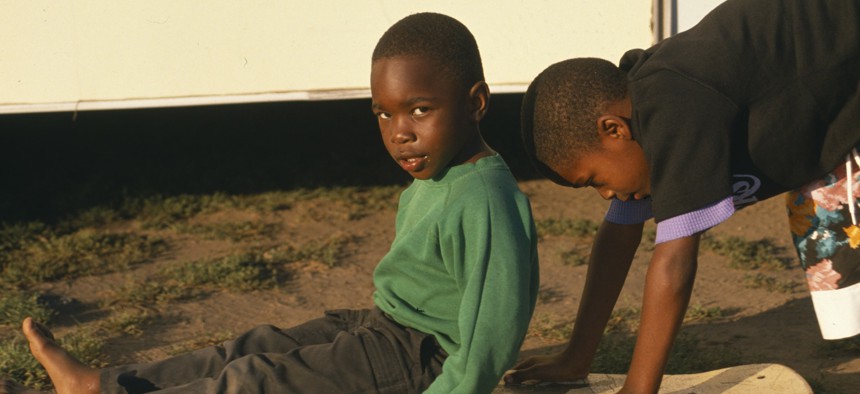White House Poverty Summit Looks at Ways to Address Child Welfare

Joseph Sohm / Shutterstock.com
Leaders focus on nutrition and two-generation approaches to helping children growing up in poverty.
WASHINGTON — The White House Rural Council’s Poverty Summit focused on the plight of children growing up in poor families and rallied around better nutrition and coordinated multi-generational approaches as key building blocks to improving their lives.
Tuesday’s summit, chaired by U.S. Agriculture Secretary Tom Vilsack, was held as part of the annual legislative conference of the National Association of Counties in the nation’s capital. It featured speakers from key federal agencies involved in anti-poverty programs, academics who have studied the problem, and officials who are on the front lines of the battle in the nation’s rural counties.
Coinciding with the conference, the University of New Hampshire’s Carsey School of Public Policy released new data showing how persistent poverty has been across three decades in certain areas of the country.
Among key findings of the Carsey Research brief:
- 64 percent of rural counties had high child poverty—20 percent or more—in 2010. Urban counties are not as poor: 47 percent had high child poverty rates.
- Persistent high poverty is clustered in Appalachia, the Mississippi Delta, much of the Southeast and in the Great Plains.
- Persistent child poverty is much more common in rural than in urban areas.
- Minority children are much more likely to live in poverty than are non-Hispanic whites.
- More than three quarters of counties with persistent high child poverty have substantial minority populations.
The findings underlined the merits of the two-generation approach to dealing with child poverty, a strategy that’s been developed by several private foundations.
The Tuesday session was keynoted by Dorothy McAuliffe, wife of Virginia Gov. Terry McAuliffe, who himself had appeared at the NACo gathering the day before. In Virginia, she said, some 300,000 children, or one in six, regularly experience hunger. She noted that last year, for the first time, more than half of the nation’s public school children were eligible for free or reduced-price lunches.
McAuliffe asserted that nutrition “has been overlooked far too long” as a key ingredient in children’s prospects for success. Hungry children are simply not ready to learn, she said. “School nutrition is as important as textbooks. They have long been seen as a children’s right, and been provided free. We should be treating nutrition the same way.” She thanked Vilsack for a recent $8.8 million grant to deal with rural nutrition, particularly in southwestern Virginia where “there’s pervasive childhood poverty.”
McAuliffe also described innovations in child feeding programs. The traditional before-school breakfast program is not adequately serving the needy, she said, and so her husband’s state budget proposes $2 million for a “breakfast after the bell” program providing food in the classrooms. She and other speakers during the summit also said more should be done to facilitate nutrition assistance during the summer, when school is not in session. Bureaucratic and transportation obstacles have been problematic in the summer months.
Children’s nutrition programs are currently up for reauthorization by Congress, and McAuliffe urged her audience to support a generous bill.
Donald Wayne, a colorful professor at North Dakota State University, described how difficult it is to get decent food on Indian reservations in his state and neighboring South Dakota—which together have five of the nine poorest counties in the nation. These counties are in a “food desert,” he said, without access to healthy meals. He showed a slide of “The Food Shop” on one of the reservations, saying it had proved that “anything can be breaded and deep-fried.”
Across the dirt road was the other major store—a gas station doubling as a grocery store. There, the emphasis is on processed foods, canned goods, frozen deep-fried foods, he said. The small section labeled “fresh fruits and veggies” has sparse offerings sold at high prices.
He described his diet growing up on the reservation: “Government cheese, white flour, spam-like meat, grape juice that wasn’t much more than water and flavoring, and pure corn syrup.”
A promising private sector approach to addressing the child poverty challenge was offered by Dr. Bernard Dreyer, president of the American Academy of Pediatrics. He talked first of the many health problems deriving from living in poverty: vulnerability to violence, injury, asthma, obesity and “toxic stress.” In turn these lead to higher rates of crime, teenage pregnancy and drug and alcohol addiction, he added. “It’s an intergenerational problem,” he observed.
“With our X-rays and stethoscopes, we cannot diagnose poverty,” Dreyer said. But in a new initiative by the Academy he heads, doctors will now be advised to “screen for poverty risk factors” and to connect needy children with others who can help them.
Addiction to prescription painkillers and heroin was top-of-mind during the NACo conference, and the rural poverty summit heard a presentation on the topic from Joe Ryan, manager of the Office of Drug Control Policy in Harford County, Maryland.
His county, located northeast of Baltimore, had seen 265 drug-overdose deaths in 2008-2014, exceeding the total of homicides and fatal car crashes in the same period, he said. Five town hall meetings in middle schools have attracted some 1,300 people, he said, and he added that he’s been using social media to spread the word on the destructive consequences of narcotics use.
It was apparent at the session that it’s no longer politically incorrect to focus on the intergenerational transferral of “persistent poverty,” nor to focus on its prevalence in minority communities. And although the “two-generation” approach to dealing with the problem is quite new, many praised the idea. A full explanation of the approach is found on the Annie E. Casey Foundation’s website, and also on that of the Aspen Institute.
Timothy B. Clark is Editor-at-Large at Government Executive’s Route Fifty. (Photo by Joseph Sohm / Shutterstock.com)
NEXT STORY: Louisiana Legislature Advances Tax Bills to Knock Out Huge Budget Deficit






